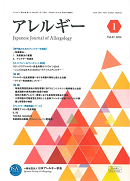
- |<
- <
- 1
- >
- >|
-
Koichi Yamaguchi2016 Volume 65 Issue 7 Pages 893-900
Published: 2016
Released on J-STAGE: August 20, 2016
JOURNAL FREE ACCESSDownload PDF (553K) -
Akira Akasawa2016 Volume 65 Issue 7 Pages 901-906
Published: 2016
Released on J-STAGE: August 20, 2016
JOURNAL FREE ACCESSDownload PDF (379K)
-
Makoto Nagata2016 Volume 65 Issue 7 Pages 908-912
Published: 2016
Released on J-STAGE: August 20, 2016
JOURNAL FREE ACCESSDownload PDF (388K)
-
Wako Yumura2016 Volume 65 Issue 7 Pages 913-920
Published: 2016
Released on J-STAGE: August 20, 2016
JOURNAL FREE ACCESSDownload PDF (411K) -
Yukinori Okada2016 Volume 65 Issue 7 Pages 921-925
Published: 2016
Released on J-STAGE: August 20, 2016
JOURNAL FREE ACCESSDownload PDF (715K) -
Masato Kubo2016 Volume 65 Issue 7 Pages 926-931
Published: 2016
Released on J-STAGE: August 20, 2016
JOURNAL FREE ACCESSDownload PDF (386K)
-
Shigeaki Suda, Rio Konno, Hajime Kurosawa, Gen Tamura2016 Volume 65 Issue 7 Pages 932-936
Published: 2016
Released on J-STAGE: August 20, 2016
JOURNAL FREE ACCESSObjective: Because dry powder inhalers (DPI) aerosolize agents by means of inspiration of patients themselves, inspiratory resistance of DPI is an important factor for increasing inhalation efficiency. Therefore, we measured inspiratory resistance of DPI of agents for asthma control.
Methods: Using Flow/Volume Simulator, when setting flow rates at 6, 30, 60, 90, and 120L/min, we read off suction pressures and find inspiratory resistances by calculation (=suction pressure/flow rate) at each flow rate.
Results: In all DPI, inspiratory resistance increases with the increasing flow rate. To maintain flow rate of 60L/min, suction pressure of around 20-cmH2O for Diskus® and Ellipta®, between 35- and 45-cmH2O for Turbuhaler ®, and about 60-cmH2O for Twisthaler® were needed.
Conclusion: It is suggested that we should instruct patients to inhaler DPI based on inspiratory resistance of the DPI.
View full abstractDownload PDF (299K)
-
Shunichi Gamo, Hideya Iijima, Yumika Seki, Ryo Horaguchi, Yuji Suda, Y ...2016 Volume 65 Issue 7 Pages 937-941
Published: 2016
Released on J-STAGE: August 20, 2016
JOURNAL FREE ACCESSAn atopic asthmatic of 65-year-old man who was complicated with COPD and treated with inhaled corticosteroid, long-acting β2 agonist, long-acting muscarinic antagonist, and leukotriene receptor antagonist was hospitalized with a severe asthmatic attack. He was intubated and went onto an artificial respirator. He was gradually relieved by repeated intravenous administration of high-dose corticosteroid, and a respirator was switched over to non-invasive positive pressure ventilation on 24th day. However, he repeated asthmatic attacks which needed corticosteroid to recover. Omalizumab was administered on 35th day and asthmatic attacks remarkably decreased. He left the hospital on 71st day. It was thought that the additional administration of omalizumab provided a good clinical response for an intractable asthma.
View full abstractDownload PDF (398K)
-
Takanori Imai, Chizuko Sugizaki, Motohiro Ebisawa2016 Volume 65 Issue 7 Pages 942-946
Published: 2016
Released on J-STAGE: August 20, 2016
JOURNAL FREE ACCESSDownload PDF (316K)
-
[in Japanese], [in Japanese]2016 Volume 65 Issue 7 Pages 947-948
Published: 2016
Released on J-STAGE: August 20, 2016
JOURNAL FREE ACCESSDownload PDF (192K) -
[in Japanese]2016 Volume 65 Issue 7 Pages 949-950
Published: 2016
Released on J-STAGE: August 20, 2016
JOURNAL FREE ACCESSDownload PDF (192K) -
[in Japanese]2016 Volume 65 Issue 7 Pages 951-952
Published: 2016
Released on J-STAGE: August 20, 2016
JOURNAL FREE ACCESSDownload PDF (210K)
- |<
- <
- 1
- >
- >|